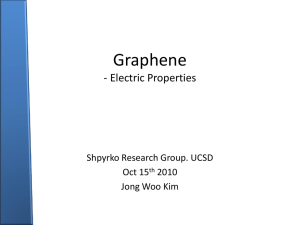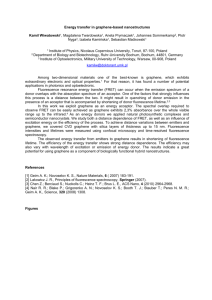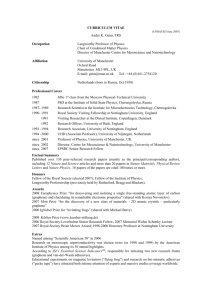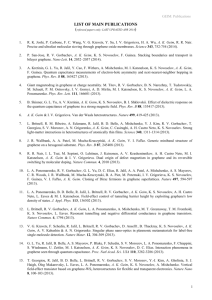curriculum vitae - Condensed Matter Physics
advertisement
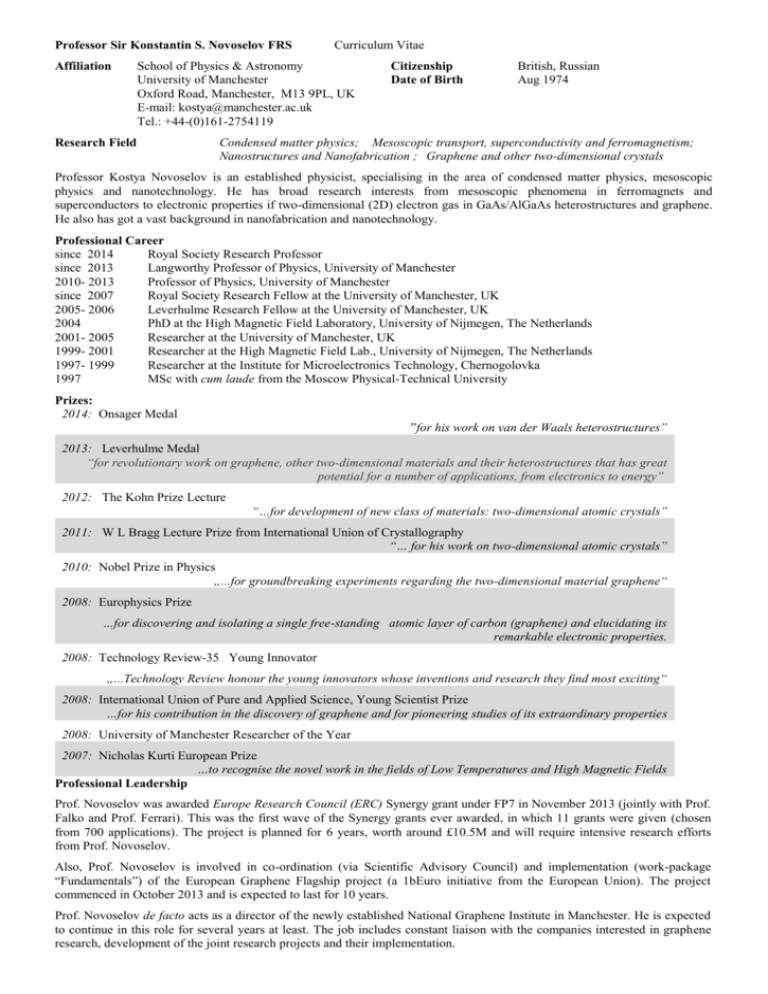
Professor Sir Konstantin S. Novoselov FRS Affiliation Curriculum Vitae School of Physics & Astronomy University of Manchester Oxford Road, Manchester, M13 9PL, UK E-mail: kostya@manchester.ac.uk Tel.: +44-(0)161-2754119 Research Field Citizenship Date of Birth British, Russian Aug 1974 Condensed matter physics; Mesoscopic transport, superconductivity and ferromagnetism; Nanostructures and Nanofabrication ; Graphene and other two-dimensional crystals Professor Kostya Novoselov is an established physicist, specialising in the area of condensed matter physics, mesoscopic physics and nanotechnology. He has broad research interests from mesoscopic phenomena in ferromagnets and superconductors to electronic properties if two-dimensional (2D) electron gas in GaAs/AlGaAs heterostructures and graphene. He also has got a vast background in nanofabrication and nanotechnology. Professional Career since 2014 Royal Society Research Professor since 2013 Langworthy Professor of Physics, University of Manchester 2010- 2013 Professor of Physics, University of Manchester since 2007 Royal Society Research Fellow at the University of Manchester, UK 2005- 2006 Leverhulme Research Fellow at the University of Manchester, UK 2004 PhD at the High Magnetic Field Laboratory, University of Nijmegen, The Netherlands 2001- 2005 Researcher at the University of Manchester, UK 1999- 2001 Researcher at the High Magnetic Field Lab., University of Nijmegen, The Netherlands 1997- 1999 Researcher at the Institute for Microelectronics Technology, Chernogolovka 1997 MSc with cum laude from the Moscow Physical-Technical University Prizes: 2014: Onsager Medal ”for his work on van der Waals heterostructures” 2013: Leverhulme Medal “for revolutionary work on graphene, other two-dimensional materials and their heterostructures that has great potential for a number of applications, from electronics to energy” 2012: The Kohn Prize Lecture “…for development of new class of materials: two-dimensional atomic crystals” 2011: W L Bragg Lecture Prize from International Union of Crystallography “… for his work on two-dimensional atomic crystals” 2010: Nobel Prize in Physics „...for groundbreaking experiments regarding the two-dimensional material graphene“ 2008: Europhysics Prize …for discovering and isolating a single free-standing atomic layer of carbon (graphene) and elucidating its remarkable electronic properties. 2008: Technology Review-35 Young Innovator „...Technology Review honour the young innovators whose inventions and research they find most exciting“ 2008: International Union of Pure and Applied Science, Young Scientist Prize …for his contribution in the discovery of graphene and for pioneering studies of its extraordinary properties 2008: University of Manchester Researcher of the Year 2007: Nicholas Kurti European Prize …to recognise the novel work in the fields of Low Temperatures and High Magnetic Fields Professional Leadership Prof. Novoselov was awarded Europe Research Council (ERC) Synergy grant under FP7 in November 2013 (jointly with Prof. Falko and Prof. Ferrari). This was the first wave of the Synergy grants ever awarded, in which 11 grants were given (chosen from 700 applications). The project is planned for 6 years, worth around £10.5M and will require intensive research efforts from Prof. Novoselov. Also, Prof. Novoselov is involved in co-ordination (via Scientific Advisory Council) and implementation (work-package “Fundamentals”) of the European Graphene Flagship project (a 1bEuro initiative from the European Union). The project commenced in October 2013 and is expected to last for 10 years. Prof. Novoselov de facto acts as a director of the newly established National Graphene Institute in Manchester. He is expected to continue in this role for several years at least. The job includes constant liaison with the companies interested in graphene research, development of the joint research projects and their implementation. 2 Awards: 2013: Elected a foreign member of the Bulgarian Academy of Science 2013: Awarded Langworthy professor of physics, University of Manchester 2013: Awarded the Honorary Freedom of the City of Manchester for his groundbreaking work on graphene 2012: Chosen among “Britain’s 50 New Radicals” by NESTA and The Observer 2011: Awarded Knighthood of the British Empire (Knight Bachelor) for his service to Science 2011: Awarded honorary degree of Doctor of Science from the University of Manchester 2011: Elected Fellow of the Royal Society 2011: Elected Honorary Fellow of the Royal Society of Chemistry 2011: Elected Honorary Fellow of the Institute of Physics 2010: Awarded Knight Commander of the Order of the Netherlands Lion for his service to Science 2010: Awarded Honorary Professor of Moscow Institute of Physics and Technology (State University) 2008: European Research Council, Starting Grant “Physics and Applications of Graphene” 2006: Royal Society Research Fellowship “The scheme by The Royal Society aims to provide outstanding scientists, who should have the potential to become leaders in their chosen field, with the opportunity to build an independent research career.” 2004: The Leverhulme Trust, Early Career Fellowship Publications Novoselov has published over 200 papers (mainly as the leading or the corresponding author) with 18 papers in Nature and Science, more than 27 Nature Physics, Nature Materials, Nature Nanotechnology and Nature Communications papers and more than a dozen Physical Review Letters. Novoselov’s two papers in Science 2004 and Nature 2005 are the most cited papers on graphene and “have opened up a fast moving front” (according to ISI’s Essential Science IndicatorsSM). The Science paper has also been acknowledged as “one of the most cited recent papers in the field of Physics” (according to the ISI citation index, cited more than 16,000 times). In 2014 Kostya Novoselov was included in the list of the most highly cited researchers. He was also named among the 17 hottest researchers world-wide - "individuals who have published the greatest number of hot papers during 2012-2013" Kostya Novoselov made into a shortlist of scientists with multiple hot papers for the years 2007-2008 (shared second place with 13 hot papers) and 2009 (5th place with 12 hot papers). Total citations: > 70,000 times. h-index 75. Current citation rate: > 17,000 per annum 3 RÉSUMÉ OF RESEARCH (in chronological order) Mesoscopic Superconductivity. Novoselov has participated in development of a pioneering technique named ballistic Hall magnetometry, which for the first time allowed magnetisation measurements of individual superconductors of submicron size. This work has led to a number of surprising and counter-intuitive observations, such as giant, fractional and “negative” vortices and the paramagnetic Meissner effect. The work has received significant media attention, including dozens of articles in scientific magazines. A.K. Geim, S.V. Dubonos, I.V. Grigorieva, K.S. Novoselov, F.M. Peeters & V.A. Schweigert. Non-Quantized Penetration of Magnetic Field in the Vortex State of Superconductors, Nature 407, 55-57 (2000). Sub-atomic movements of magnetic domain walls. Novoselov has exploited the technique of ballistic Hall micromagnetometry to detect sub-nanometre changes in the position of individual domain walls in ferromagnetic materials. In particular, he has succeeded in the first direct observation of a condensed-matter object (a domain wall, in this case) moving between adjacent Peierls valleys and discovered a new unexpected mechanism of its propagation between the valleys. K.S. Novoselov, A.K. Geim, S.V. Dubonos, E.W. Hill, I.V. Grigorieva. Subatomic Movements of a Domain Wall in the Peierls Potential, Nature 426, 812-816 (2003). Gecko tape. Novoselov took an active part in demonstration of a new microfabricated adhesive, which is based on the same physics mechanism that underlies the amazing climbing ability of geckos. The work is highly rated among experts as the first proof of concept of dry adhesives based on van der Waals interaction. The research also attracted significant media attention. Several large and well-funded research groups, including labs at DuPont and TESA, now follow our work and have established their own research programmes on gecko tape. A.K. Geim, S.V. Dubonos, I.V. Grigorieva, K.S. Novoselov, A.A. Zhukov, S.Y. Shapoval. Microfabricated Adhesive Mimicking Gecko Foot-Hair, Nature Materials 2, 461-463 (2003). Two-Dimensional Atomic Crystals. Most recently, Novoselov has reported the discovery of a new class of materials – free-standing two-dimensional crystals – including single layers of graphite, boron-nitride, several dichalcogendes and complex oxides. Unexpectedly, these atomically-thin sheets (essentially gigantic 2D molecules unprotected from the immediate environment) are stable under ambient conditions, exhibit high crystal quality and are continuous on a macroscopic scale. For example, graphene (a monolayer of graphite) can be viewed as a flat fullerene molecule or as millions of carbon nanotubes somehow unrolled and stitched together. There is no doubt about the exceptional new physics that graphene offers. Quasiparticles in graphene behave like massless relativistic fermions described by the Dirac equation rather than the standard Schrödinger equation that is used to describe other materials. Novoselov has proven this in a series of elaborate experiments that led to a new paradigm of “relativistic-like condensed matter” where quantum relativistic phenomena can now be studied in bench-top nanoscience experiments. He also demonstrated first electronic devices based on graphene, which significantly improved prospects of carbon-based electronics beyond the Si age. One-atom-thick membranes made by Novoselov and coworkers group opened up new horizons in many technological areas. For review, see A.K. Geim, K.S. Novoselov. The rise of graphene. Nature Materials 6, 183-191 (2007). K.S. Novoselov, A.K. Geim, S.V. Morozov, D. Jiang, Y. Zhang, S.V. Dubonos, I.V. Grigorieva, & A.A. Firsov. Electric Field Effect in Atomically Thin Carbon Films, Science 306, 666-669 (2004). K.S. Novoselov, D. Jiang, T. Booth, V.V. Khotkevich, S. V. Morozov, & A.K. Geim. Two Dimensional Atomic Crystals. PNAS 102, 10451-10453 (2005). K.S. Novoselov, A.K. Geim, S. V. Morozov, M.I. Katsnelson, I.V. Grigorieva, S.V. Dubonos, & A.A. Firsov. Two Dimensional Gas of Massless Dirac Fermions in Graphene, Nature 438, 197-200 (2005). K.S. Novoselov, E. McCann, S.V. Morozov, V.I. Fal'ko, M.I. Katsnelson, U. Zeitler, D. Jiang, F. Schedin, & A.K. Geim. Unconventional quantum Hall effect and Berry's phase of 2 in bilayer graphene, Nature Phys. 2, 177-180 (2006). K.S. Novoselov, Z. Jiang, Y. Zhang, S.V. Morozov, H.L Stormer, U. Zeitler, J.C. Maan, G.S. Boebinger, P. Kim, & A.K. Geim. Room-temperature quantum hall effect in graphene, Science 315, 1379 (2007). J.C. Meyer, A.K. Geim, M.I. Katsnelson, K.S. Novoselov, T.J. Booth, & S. Roth. The structure of suspended graphene sheets, Nature 446, 60-63 (2007). L. A. Ponomarenko, F. Schedin, M. I. Katsnelson, R. Yang, E. W. Hill, K. S. Novoselov, & A. K. Geim. Chaotic Dirac Billiard in Graphene Quantum Dots, Science 320, 356-358 (2008). D. C. Elias, R. R. Nair, T. M. G. Mohiuddin, S. V. Morozov, P. Blake, M. P. Halsall, A. C. Ferrari, D. W. Boukhvalov, M. I. Katsnelson, A. K. Geim, & K. S. Novoselov. Control of Graphene's Properties by Reversible Hydrogenation: Evidence for Graphane, Science 323, 610-613 (2009). A. S. Mayorov, D. C. Elias, M. Mucha-Kruczynski, R. V. Gorbachev, T. Tudorovskiy, A. Zhukov, S. V. Morozov, M. I. Katsnelson, V. I. Fal'ko, A. K. Geim, & K. S. Novoselov. Interaction-Driven Spectrum Reconstruction in Bilayer Graphene, Science 333(6044), 860-63 (2011). D. A. Abanin, S. V. Morozov, L. A. Ponomarenko, R. V. Gorbachev, A. S. Mayorov, M. I. Katsnelson, K. Watanabe, T. Taniguchi, K. S. Novoselov, L. S. Levitov, & A. K. Geim. Giant Nonlocality Near the Dirac Point in Graphene Science 332(6027), 328-30 (2011).
